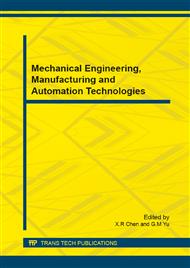[1]
Rusu R B. Semantic 3D object maps for everyday manipulation in human living environments[J]. KI-Künstliche Intelligenz, 2010, 24(4): 345-348.
DOI: 10.1007/s13218-010-0059-6
Google Scholar
[2]
Schnabel R, Wahl R, Klein R. Efficient RANSAC for Point‐Cloud Shape Detection[C], Computer Graphics Forum. Blackwell Publishing Ltd, 2007, 26(2): 214-226.
DOI: 10.1111/j.1467-8659.2007.01016.x
Google Scholar
[3]
Lukács G, Martin R, Marshall D. Faithful least-squares fitting of spheres, cylinders, cones and tori for reliable segmentation[M]. Computer Vision—ECCV'98. Springer Berlin Heidelberg, 1998: 671-686.
DOI: 10.1007/bfb0055697
Google Scholar
[4]
Lukiacs G, Marshall A D, Martin R R. Geometric least-squares fitting of spheres, cylinders, cones and tori[J]. Preprint, University of Wales, Cardiff, (1997).
Google Scholar
[5]
Shakarji C M. Least-squares fitting algorithms of the NIST algorithm testing system[J]. Journai of research-national institute of standards and technology, 1988, 103: 633-641.
DOI: 10.6028/jres.103.043
Google Scholar
[6]
Sun Chunjuan, Zhu Binhai, Wang Wencheng. Optimizing Conical Reconstruction of Linear Point Clouds[J], Journal of Computer Aided Design and Computer Graphics, 2010(8): 1324-1330.
DOI: 10.3724/sp.j.1089.2010.10979
Google Scholar
[7]
Tian Huaiwen, Guo Shizhang. Research on Algorithm of Quadric Surface Fitting in Reverse Modeling for Mechanical Parts[J]. Journal of Southwest Jiaotong University, 2007, 42(5): 553-557.
Google Scholar
[8]
Li An, Guan Aizhi. Fitting Point Cloud to Cone and Cylinder Based on Guassian Image[J]. Modular Machine Tool & Automatic Manufacturing Technique. 2007, 8: 28-32.
Google Scholar
[9]
Qu Xuejun, Yang Yawen, Han Zhiren, Quadric Surface Direct Fitting Based on Normal Vectors of Random Data[J]. Acta Aeronautica et Astronautica Sinica, 2007, 28(4): 1018-1020.
Google Scholar
[10]
Gong Xiuqiang, Wang Jiexian, Fitting circular conical surface[J]. Geotechnical investigation and surveying, 2010, 38(10): 79-82.
Google Scholar
[11]
Madsen K, Nielsen H B, Tingleff O. Methods for non-linear least squares problems[M], (1999).
Google Scholar
[12]
Hoppe H, DeRose T, Duchamp T, et al. Surface reconstruction from unorganized points[M]. ACM, (1992).
Google Scholar
[13]
Ding Zhenliang, Error theory and data processing[M], HARBIN INSTITUTE OF TECHNOLOGY PRESS, (1999).
Google Scholar
[14]
Ding Zhenliang, Error theory and data processing[M], HARBIN INSTITUTE OF TECHNOLOGY PRESS, (1999).
Google Scholar


